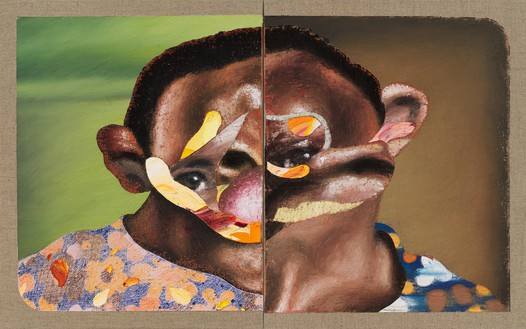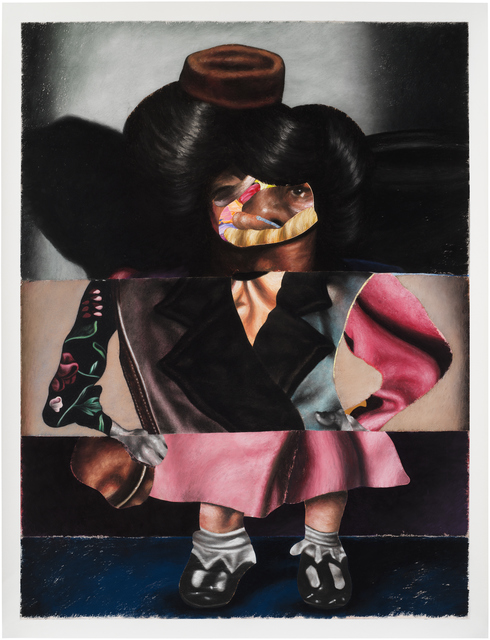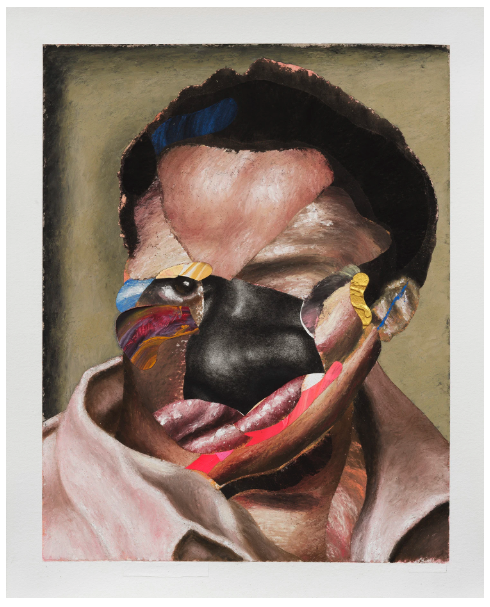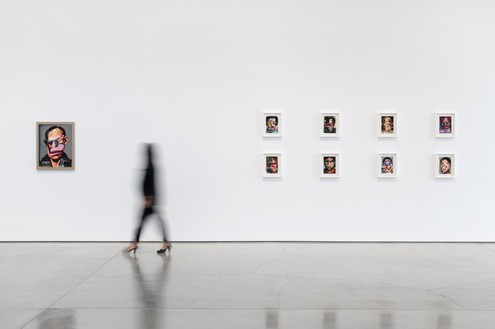At first glance and from afar, Nathaniel Mary Quinn’s imagery appears to be photo-collage, but upon close viewing, the works are actually painted. What immediately comes to mind is the work of Francis Bacon, Romaire Bearden, Deborah Roberts, and the Surrealist parlor game Exquisite Corpse. Quinn divides many of his images into sections and juxtaposes elements from multiple sources to create composite faces comprised of contorted and uncanny features. The works are unsettling and seductive simultaneously. Quinn uses magazine clippings he has collected as well as pictures of friends and easily combines them at different scales in the final compositions. In addition to juxtaposing different types of imagery, he also combines materials including oil paint, oil stick, gouache, charcoal, and pastel.

Nathaniel Mary Quinn, Jekyll and Hyde, (2019) 14 x 22in. Courtesy of Gagosian.
In his first exhibition at Gagosian Gallery, Quinn presents works on paper, as well as canvases ranging in scale from the intimate to the monumental. Among the largest is Vaseline, (all works 2019) a vertical diptych 96 inches tall that divides the canvas into uneven thirds. In the bottom portion of the composition, non-human feet emerge from the bottom of dark-colored wide-leg pants. The middle third is the smallest section and spans the diptychs divide. Here, Quinn depicts the next body part — the upper-thighs— one leg in red pants, the other purple. At the very top of this section are what appear to be grotesque hands that hang down from a jacketed upper body in the top third of the image. Against a maudlin, tan colored background sits a head whose neck and shoulders are covered by an oversized black dressy collar. The figure’s face is an amalgamation of lips, ears, and nose that resemble the discolored and distorted face of ‘Howdy Doody.’ In addition to Vaseline, Farewell, C’mo’ And Walk With Me and Above and Below are also comprised of collaged body parts, while the many other works are more traditional three-quarter portraits.

Nathaniel Mary Quinn, C’mo’ and Walk with Me (2019) 50 x 38 in. Courtesy of Gagosian.
Hiding in Plain Discomfort is hard to look at. The male figure is a melange of textures and colors that cohere as a distorted face. A single dark piercing eye stares out at the viewer. Next to the eye is an oversized nose rendered in charcoal surrounded by skin-toned fragments that appear to have been cut and collaged from myriad sources. A halo of short black-brown hair surrounds the fractured forehead. Fragmented swirls of color combine in a Francis Bacon-esque application of paint to suggest the rest of the facial features. It is as hard to look away as it is to make out what or who is being depicted.

Nathaniel Mary Quinn, Hiding in Plain Discomfort (2019) 16 x 13 in. Courtesy of Gagosian.
While the depiction of ethnicity and/or race are present in this work, they are not foregrounded. Quinn has remarked that he puts his images together intuitively, creating compositions based on balance, form and color. He creates psychological portraits that put forth the inner personality of his subjects as a combination of perception and memory. Quinn’s difficult early life echoes through his work as he skillfully combines a patchwork of body parts— often violently cut and combined in an aggressive manner, evoking an emotional response from his viewers. There is a powerful resolve to the work. It is confident, not hesitant in any way and celebrates Quinn’s command of his chosen mediums. Yet, it is also schizophrenic: each portrait displays multiple personalities, as in Jekyll and Hyde. Here, Quinn divides the composition in two, emphasizing the dual nature of the character. The schisms within the work are evocative, inviting the viewer to imagine the motivations behind the manipulations. While the “who” might only be known to Quinn, he has created a body of work that speaks directly to these troubled times and the internal and external uncertainties facing all of us.
Nathaniel Mary Quinn Hollow and Cut
Gagosian Gallery
September 11 – October 19, 2019


